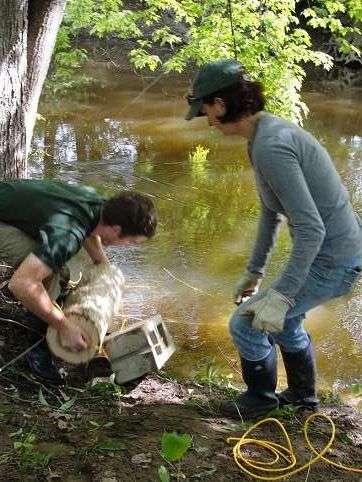Basketmakers' tradition of storing black ash logs in water effective in killing EAB

Using a combination of traditional ecological knowledge and science, a USDA Forest Service research team has demonstrated that the traditional method of storing black ash logs can save one of the emerald ash borer's potential causalities - the traditional art of ash basketmaking.
Working with artisans from the Match-e-be-nash-she-wish Band of Potawatomi Indians of Michigan near Gun Lake, Mich., scientists from the USDA Forest Service and the USDA Animal and Plant Health Inspection Service (APHIS) tested the traditional practice of storing black ash logs submerged in rivers to determine whether it can both effectively preserve ash logs for basketmaking and kill emerald ash borer (EAB) larvae lurking under the bark of ash trees and prevent emergence of adults. The study found that submerging logs for 18 weeks during winter or 14 weeks in spring killed EAB and also retained the wood's quality for basketmaking.
The study was published in the journal Agricultural and Forest Entomology and is available at: http://onlinelibrary.wiley.com/doi/10.1111/afe.12122/epdf
"Black ash has special importance for American Indian and First Nations people in the Great Lakes region and northeastern North America," said Michael T. Rains, Director of the Forest Service's Northern Research Station and the Forest Products Laboratory. "This collaboration will help strengthen a centuries old art and will also help slow the spread of the emerald ash borer, one of the most destructive non-native forest insects in the nation."
Black ash has been prized for centuries by traditional basketmakers for its ring-porous wood, which allows layers of xylem - the cells and vessels that transport water up a tree and creates tree rings - to be easily separated. The loss of black ash to the emerald ash borer has sparked concern about preserving black ash for use in basketmaking as well as the potential for spreading EAB by transporting untreated logs from forests to locations where they are pounded and split and ultimately used for basketmaking.
In 2010 and 2011, logs infested with emerald ash borer were submerged for different time periods during winter and spring. All of the treatments studied in the experiment were developed in accordance with Match-e-be-nash-she-wish Band guidelines, with logs submerged in a stream of moving water at different times for the year and for various periods of time. The study also examined the effects of submergence on wood splint color and properties.
"Meeting the needs of American Indian artisans was an objective of the research from study design through evaluation of the suitability of submerged logs for basketmaking," according to co-author Marla R. Emery, a research geographer with the Forest Service's Northern Research Station. "Our hope is that guidelines based on this research will help prevent the inadvertent spread of EAB and preserve as much ash as possible for basketmaking."
A variety of factors help insects survive for some weeks in submerged logs. "Insects have a remarkable ability to adapt and survive," said lead author Therese Poland, a research entomologist with the Forest Service's Northern Research Station. "In the winter, EAB larvae survive longer because they are already dormant and are acclimated to the cold. In the spring, we found larvae surviving for several weeks in submerged logs, possibly because the tree's bark protects them from contact with water for some period of time."
Provided by USDA Forest Service


















